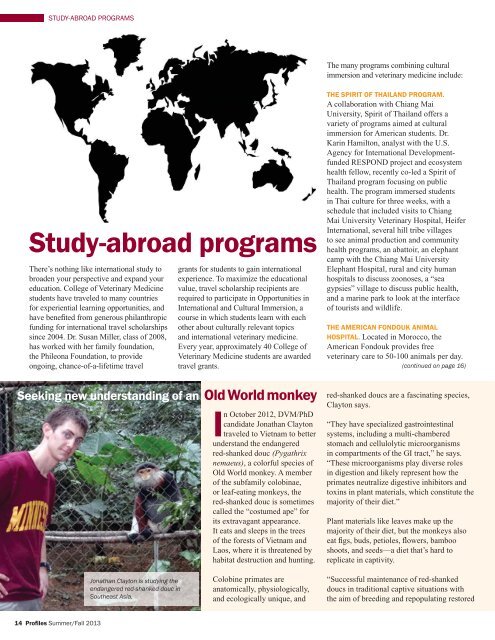Summer/Fall 2013 PDF - University of Minnesota College of ...
Summer/Fall 2013 PDF - University of Minnesota College of ...
Summer/Fall 2013 PDF - University of Minnesota College of ...
You also want an ePaper? Increase the reach of your titles
YUMPU automatically turns print PDFs into web optimized ePapers that Google loves.
STUDY-ABROAD PROGRAMS<br />
The many programs combining cultural<br />
immersion and veterinary medicine include:<br />
Study-abroad programs<br />
There’s nothing like international study to<br />
broaden your perspective and expand your<br />
education. <strong>College</strong> <strong>of</strong> Veterinary Medicine<br />
students have traveled to many countries<br />
for experiential learning opportunities, and<br />
have benefited from generous philanthropic<br />
funding for international travel scholarships<br />
since 2004. Dr. Susan Miller, class <strong>of</strong> 2008,<br />
has worked with her family foundation,<br />
the Phileona Foundation, to provide<br />
ongoing, chance-<strong>of</strong>-a-lifetime travel<br />
grants for students to gain international<br />
experience. To maximize the educational<br />
value, travel scholarship recipients are<br />
required to participate in Opportunities in<br />
International and Cultural Immersion, a<br />
course in which students learn with each<br />
other about culturally relevant topics<br />
and international veterinary medicine.<br />
Every year, approximately 40 <strong>College</strong> <strong>of</strong><br />
Veterinary Medicine students are awarded<br />
travel grants.<br />
Seeking new understanding <strong>of</strong> an Old World monkey<br />
In October 2012, DVM/PhD<br />
candidate Jonathan Clayton<br />
traveled to Vietnam to better<br />
understand the endangered<br />
red-shanked douc (Pygathrix<br />
nemaeus), a colorful species <strong>of</strong><br />
Old World monkey. A member<br />
<strong>of</strong> the subfamily colobinae,<br />
or leaf-eating monkeys, the<br />
red-shanked douc is sometimes<br />
called the “costumed ape” for<br />
its extravagant appearance.<br />
It eats and sleeps in the trees<br />
<strong>of</strong> the forests <strong>of</strong> Vietnam and<br />
Laos, where it is threatened by<br />
habitat destruction and hunting.<br />
THE SPIRIT OF THAILAND PROGRAM.<br />
A collaboration with Chiang Mai<br />
<strong>University</strong>, Spirit <strong>of</strong> Thailand <strong>of</strong>fers a<br />
variety <strong>of</strong> programs aimed at cultural<br />
immersion for American students. Dr.<br />
Karin Hamilton, analyst with the U.S.<br />
Agency for International Developmentfunded<br />
RESPOND project and ecosystem<br />
health fellow, recently co-led a Spirit <strong>of</strong><br />
Thailand program focusing on public<br />
health. The program immersed students<br />
in Thai culture for three weeks, with a<br />
schedule that included visits to Chiang<br />
Mai <strong>University</strong> Veterinary Hospital, Heifer<br />
International, several hill tribe villages<br />
to see animal production and community<br />
health programs, an abattoir, an elephant<br />
camp with the Chiang Mai <strong>University</strong><br />
Elephant Hospital, rural and city human<br />
hospitals to discuss zoonoses, a “sea<br />
gypsies” village to discuss public health,<br />
and a marine park to look at the interface<br />
<strong>of</strong> tourists and wildlife.<br />
THE AMERICAN FONDOUK ANIMAL<br />
HOSPITAL. Located in Morocco, the<br />
American Fondouk provides free<br />
veterinary care to 50-100 animals per day.<br />
(continued on page 16)<br />
red-shanked doucs are a fascinating species,<br />
Clayton says.<br />
“They have specialized gastrointestinal<br />
systems, including a multi-chambered<br />
stomach and cellulolytic microorganisms<br />
in compartments <strong>of</strong> the GI tract,” he says.<br />
“These microorganisms play diverse roles<br />
in digestion and likely represent how the<br />
primates neutralize digestive inhibitors and<br />
toxins in plant materials, which constitute the<br />
majority <strong>of</strong> their diet.”<br />
Plant materials like leaves make up the<br />
majority <strong>of</strong> their diet, but the monkeys also<br />
eat figs, buds, petioles, flowers, bamboo<br />
shoots, and seeds—a diet that’s hard to<br />
replicate in captivity.<br />
Jonathan Clayton is studying the<br />
endangered red-shanked douc in<br />
Southeast Asia.<br />
Colobine primates are<br />
anatomically, physiologically,<br />
and ecologically unique, and<br />
“Successful maintenance <strong>of</strong> red-shanked<br />
doucs in traditional captive situations with<br />
the aim <strong>of</strong> breeding and repopulating restored<br />
14 Pr<strong>of</strong>iles <strong>Summer</strong>/<strong>Fall</strong> <strong>2013</strong>

















